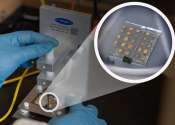ACS Nano
ACS Nano is a monthly, peer-reviewed, scientific journal, first published in August 2007 by the American Chemical Society. The current editor in chief is Paul S. Weiss (University of California, Los Angeles). The journal publishes original research articles, reviews, perspectives, interviews with distinguished researchers, views on the future of nanoscience and nanotechnology. According to the Journal Citation Reports, ACS Nano has a 2010 impact factor of 9.855.
The focus of ACS Nano is synthesis, assembly, characterization, theory, and simulation of nanostructures, nanotechnology, nanofabrication, self assembly, nanoscience methodology, and nanotechnology methodology. The focus also includes nanoscience and nanotechnology research - the scope of which is chemistry, biology, materials science, physics, and engineering.
- Publisher
- American Chemical Society
- Country
- United States
- History
- 2007-present
- Website
- http://pubs.acs.org/journal/ancac3
- Impact factor
- 9.855 (2010)
Some content from Wikipedia,
licensed under CC BY-SA









